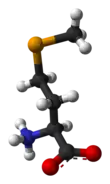Selenomethionine
Selenomethionine (SeMet) is a naturally occurring amino acid. The L-selenomethionine enantiomer is the main form of selenium found in Brazil nuts, cereal grains, soybeans, and grassland legumes, while Se-methylselenocysteine, or its γ-glutamyl derivative, is the major form of selenium found in Astragalus, Allium, and Brassica species.[1] In vivo, selenomethionine is randomly incorporated instead of methionine. Selenomethionine is readily oxidized.[2]
| |||
| Names | |||
|---|---|---|---|
| IUPAC name
2-Amino-4-(methylselanyl)butanoic acid | |||
| Other names
MSE | |||
| Identifiers | |||
3D model (JSmol) |
|||
| ChEBI | |||
| ChemSpider | |||
| ECHA InfoCard | 100.014.525 | ||
PubChem CID |
|||
| UNII |
| ||
CompTox Dashboard (EPA) |
|||
| |||
| |||
| Properties | |||
| C5H11NO2Se | |||
| Molar mass | 196.106 g/mol | ||
Except where otherwise noted, data are given for materials in their standard state (at 25 °C [77 °F], 100 kPa). | |||
| Infobox references | |||
Selenomethionine's antioxidant activity arises from its ability to deplete reactive oxygen species. Selenium and methionine also play separate roles in the formation and recycling of glutathione, a key endogenous antioxidant in many organisms, including humans.
Substitution chemistry issues
Selenium and sulfur are chalcogens that share many chemical properties so the substitution of methionine with selenomethionine may have only a limited effect on protein structure and function. However, the incorporation of selenomethionine into tissue proteins and keratin in the cattle, birds and fish causes alkali disease.[3][4][5]
Alkali disease is characterized by emaciation, loss of hair, deformation and shedding of hooves, loss of vitality, and erosion of the joints of long bones.
Incorporation of selenomethionine into proteins in place of methionine aids the structure elucidation of proteins by X-ray crystallography using single- or multi-wavelength anomalous diffraction (SAD or MAD).[6] The incorporation of heavy atoms such as selenium helps solve the phase problem in X-ray crystallography.[7]
Dietary intake
Selenomethionine is readily available as a dietary supplement. It has been suggested by nutritionists that selenomethionine, as an organic form of selenium, is easier for the human body to absorb than selenite, which is an inorganic form.[8] It was determined in a clinical trial that selenomethionine is absorbed 19% better than selenite.[8]
See also
- Selenocysteine, another selenium-containing amino acid, but one that is incorporated into specific locations of specific proteins as directed by the genetic code.
- Selenoprotein
- Canadian Reference Material of selenomethionine
References
- Whanger, P. D. (2002). "Selenocompounds in plants and animals and their biological significance". Journal of the American College of Nutrition. 21 (3): 223–32. doi:10.1080/07315724.2002.10719214. PMID 12074249. S2CID 20483595.
- Block, E.; Birringer, M.; Jiang, W.; Nakahodo, T.; Thompson, H. J.; Toscano, P. J.; Uzar, H.; Zhang, X.; Zhu, Z. (2001). "Allium chemistry: synthesis, natural occurrence, biological activity, and chemistry of Se-alk(en)ylselenocysteines and their γ-glutamyl derivatives and oxidation products". Journal of Agricultural and Food Chemistry. 49 (1): 458–70. doi:10.1021/jf001097b. PMID 11305255.
- O'Toole, D.; Raisbeck, M. F. (1995). "Pathology of experimentally induced chronic selenosis (alkali disease) in yearling cattle". Journal of Veterinary Diagnostic Investigation. 7 (3): 364–373. doi:10.1177/104063879500700312. ISSN 1040-6387. PMID 7578453.
- Spallholz, Julian E.; Hoffman, David J. (2002). "Selenium toxicity: cause and effects in aquatic birds". Aquatic Toxicology. Amsterdam, Netherlands. 57 (1–2): 27–37. doi:10.1016/S0166-445X(01)00268-5. ISSN 0166-445X. PMID 11879936.
- Lemly, A.Dennis (1997). "A Teratogenic Deformity Index for Evaluating Impacts of Selenium on Fish Populations". Ecotoxicology and Environmental Safety. 37 (3): 259–266. doi:10.1006/eesa.1997.1554. ISSN 0147-6513. PMID 9378093.
- Hendrickson, W. A. (1999). "Maturation of MAD phasing for the determination of macromolecular structures". Journal of Synchrotron Radiation. 6 (4): 845–851. doi:10.1107/S0909049599007591.
- Larsson, A. M. (2009). "Preparation and crystallization of selenomethionine protein". Protein Crystallization. IUL Biotechnology Series. 8. p. 135–154.
- "Product Review: Supplements for Cancer Prevention (Green Tea, Lycopene, and Selenium)". ConsumerLab.com. Retrieved 2008-04-20.
Selenium supplements are available in organic and inorganic forms. Some research suggests that the inorganic form, selenite, is harder for the body to absorb than organic forms such as selenomethionine (selenium bound to methionine, an essential amino acid) or high-selenium yeast (which contains selenomethionine). A recent clinical trial found that selenomethionine had 19% better absorption than selenite; absorption from selenium yeast was about 10% better than selenite.


